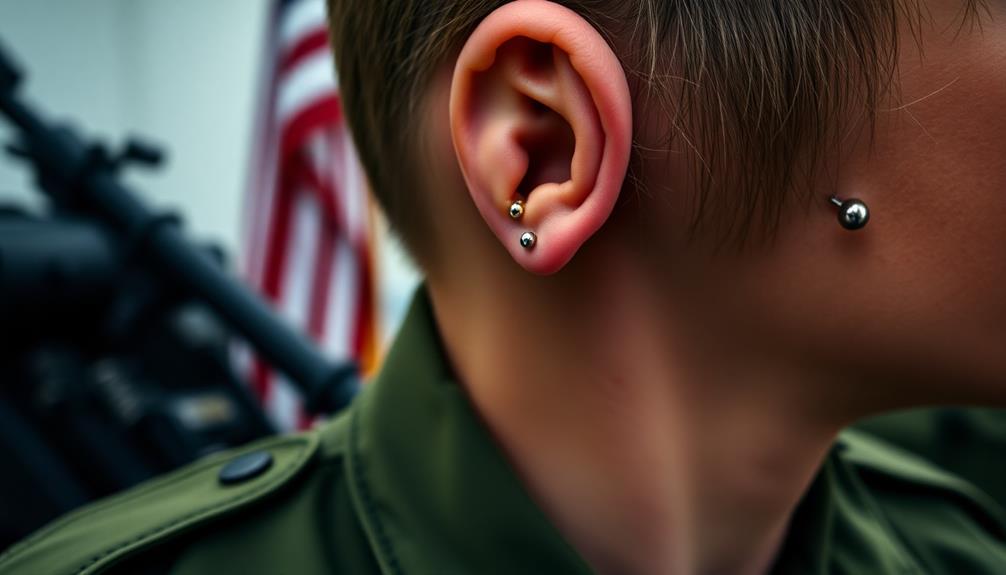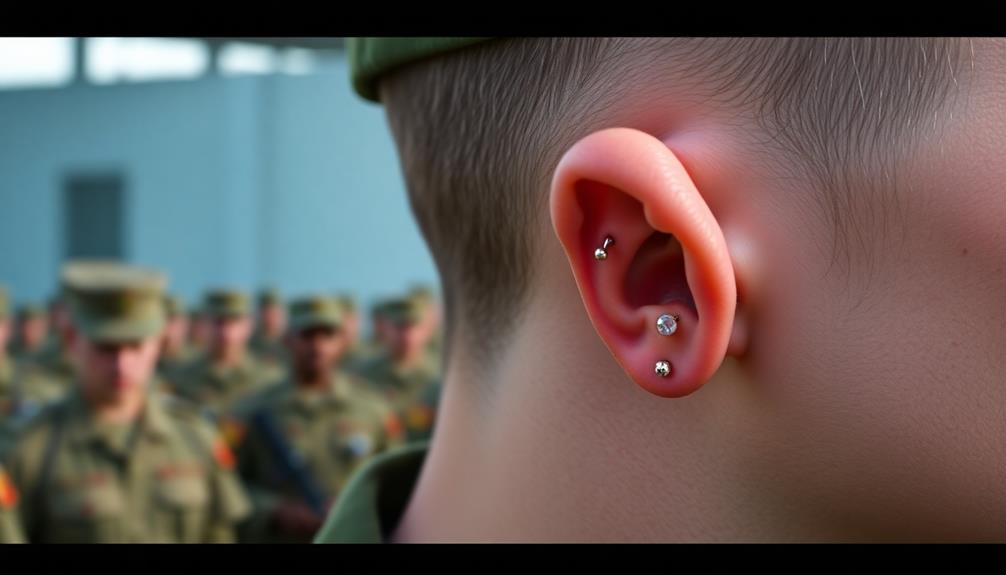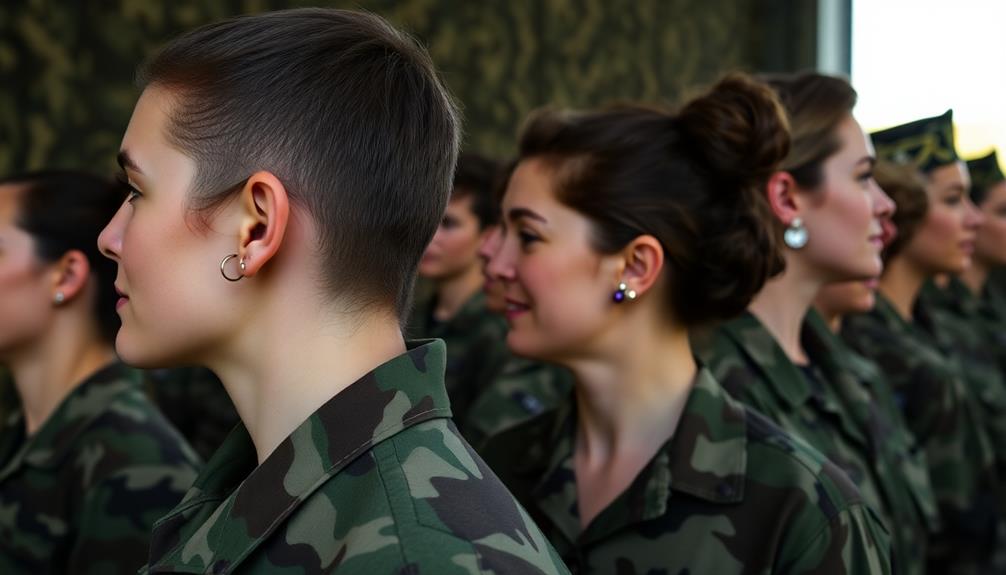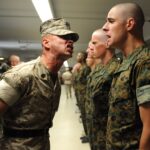In the military, regulations on piercings are strict. While visible piercings are prohibited in uniform, you can express yourself with some creative compromises. Female service members can wear one small earring per earlobe, while male service members can't wear earrings at all in uniform. If you have multiple piercings, consider using clear retainers or non-permanent, skin-safe adhesive jewelry as discreet options. Hairstyles can also help cover any forbidden piercings. Staying compliant is essential to avoid disciplinary actions, but there are ways to balance military standards with personal expression. Explore further to find more clever strategies that work for you.
Key Takeaways
- Visible body piercings are prohibited while in uniform or on official duty, maintaining professionalism across military branches.
- Male service members cannot wear earrings in uniform, while females are allowed one small, conservative earring per earlobe.
- Creative compromises include using clear retainers or non-permanent adhesive jewelry to comply with regulations while expressing individuality.
- Non-compliance with piercing regulations can lead to disciplinary actions, including reprimands or separation from service under Article 92 of UCMJ.
- Variations in enforcement of piercing regulations can create confusion and tension among service members, particularly regarding disparities between male and female policies.
Overview of Military Regulations

When serving in the military, it's crucial to understand the regulations surrounding body piercings and jewelry. The military mandates that visible body piercings are prohibited while you're in uniform or performing official duties. This rule guarantees a uniform appearance and maintains professionalism across all branches.
If you're wearing civilian attire, however, you have more freedom to express yourself.
For male service members, earrings aren't allowed while in uniform. You can wear them in civilian clothes, but it's important to remember the distinction.
Female service members can wear one small, conservative earring per earlobe, but only if it fits tightly and doesn't extend below the earlobes. This regulation helps maintain a neat and polished look.
Compliance with these piercing and jewelry regulations is mandatory, and violations can lead to disciplinary actions.
By adhering to these guidelines, you contribute to the military's standards of appearance.
Body Piercing Guidelines

Understanding body piercing guidelines is essential for all military personnel, as these rules directly impact your appearance while in uniform.
To maintain a professional military image, you must adhere to specific regulations regarding visible piercings.
Here are some key points to keep in mind:
- Visible body piercings are prohibited while in uniform or performing official duties.
- Jewelry through any exposed body part, aside from the ears, is forbidden in uniform.
- Female service members can wear one small, conservative earring per earlobe, ensuring it fits tightly and matches with no length extending below the earlobes.
- Male personnel aren't allowed to wear earrings in uniform but may do so in civilian clothes off military installations.
Compliance and Consequences

Compliance with body piercing regulations is critical for maintaining the military's professional image. As a service member, you need to understand that military guidelines prohibit visible piercings while in uniform or performing official duties. Non-compliance can lead to serious consequences, including disciplinary action under Article 92 of the Uniform Code of Military Justice.
While females are allowed to wear one small, conservative earring per earlobe, males can't wear earrings at all, even in civilian clothes on military installations. This strict adherence to body art regulations guarantees that all service members present a unified and disciplined appearance.
Commanders have discretion in enforcing these piercing regulations and may take disciplinary measures against violations. This can range from reprimands to potential involuntary separation from service.
Consequently, it's crucial to stay informed about the piercing guidelines to prevent any misunderstandings and guarantee compliance with military appearance standards. Understanding these rules not only protects your military career but also reinforces the importance of maintaining a professional image within the armed forces.
Creative Compromises

Maneuvering through the strict regulations on body piercings in the military doesn't mean you have to sacrifice your personal style.
You can find creative compromises that let you express individuality while still adhering to the rules. Here are some ideas:
- Use clear retainers for piercings; they're discreet and comply with regulations.
- Opt for a single, small, conservative earring per earlobe if you have multiple piercings.
- Try non-permanent, skin-safe adhesive jewelry to enhance your look without violating visibility rules.
- Adjust your hairstyle to cover piercings, like tying your hair back or using stylish accessories.
Impact on Service Members

The restrictions on body piercings in the military can considerably impact service members' ability to express their individuality. You might feel frustrated if you want to showcase your personal style but must adhere to strict regulations.
While female service members can wear one small, conservative earring per earlobe, male service members are prohibited from wearing earrings altogether. This disparity can create tension among service members, particularly as society becomes more accepting of tattoos or brands as forms of self-expression.
Moreover, the mandatory compliance with piercing regulations can lead to disciplinary actions for those who choose to defy the rules, which can negatively affect morale and retention rates. The fact that commanders have discretion in enforcing these regulations can add to the confusion, as you may face varying expectations across different units.
In a changing societal landscape that increasingly values individuality, these restrictions can feel outdated. As a service member, you might find yourself maneuvering a challenging balance between maintaining military standards and expressing who you are.
Ultimately, these regulations can shape your experience and sense of identity within the military environment.
Frequently Asked Questions
Do Piercings Disqualify You From the Military?
Yes, piercings can disqualify you from the military. If you have visible piercings while in uniform, it may affect your eligibility and lead to disciplinary actions, so it's best to comply with regulations.
Can You Have Piercings in Military School?
You can't just go wild with piercings in military school; it's like trying to swim in a desert. Only one conservative earring per earlobe for females is allowed, while males can't wear any earrings.
How Many Piercings Can You Have in the Army?
In the Army, you can have one small, conservative earring per earlobe if you're female, but males can't wear earrings at all. Visible piercings are generally prohibited while you're in uniform or on duty.
Can I Wear Piercings to Meps?
You can't wear piercings to MEPS. All visible body jewelry must be removed or covered. Compliance with these regulations is essential to avoid delays during your enlistment process, so plan accordingly.
Conclusion
In steering through the strict regulations on piercings in the military, it's clear that service members often find creative ways to express themselves while staying compliant. For example, a soldier might opt for clear retainers in their lip piercings during duty hours, allowing them to keep their personal style intact without drawing unwanted attention. Balancing individuality with military standards is challenging, but with some clever compromises, you can still showcase your personality while serving your country.
















